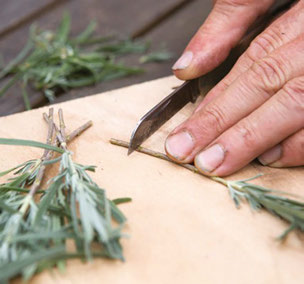Garden Notes
What to do in the garden now
With colourful blooms to enjoy, fruit to pick and wildlife to watch, the summer months can be very rewarding. Plants put on plenty of leafy growth and then burst into flower to be pollinated by bees and other insects. Weeds can be a problem, but you can keep them under control with a ‘little and often’ approach. Although there’s still plenty to be getting on with, it’s important to take the time to relax and enjoy the fruits of your labour.
Hot stuff!
Summer is when hot coloured flowers come into their own. The freshness of spring is past and summer days are finally here. The Crocosmia ‘Scorchio’ grows from corms, making it very easy to propagate. Just dig up the clump and divide in spring. Do this every couple of years. It has healthy, mid-green, blade-like leaves and strong, arching flower stems that bear large, orange-yellow flowers with red stripes in the centres of the petals, from mid-summer to autumn.
Bee positive!
To bring the buzz back to your garden and enjoy the brilliance of returning bees and butterflies there are a few simple steps to take. Firstly, learn to live without insecticides and to tolerate a few more weedy corners in the garden. Secondly, provide good shelter through the winter months. Leaves piled along the back of borders, evergreens trained over fences and walls, and maybe a patch of long grass at the far end of the lawn will ensure that nesting bees and hoverflies, moth chrysalises and hibernating butterflies have somewhere safe to shelter. Thirdly you can make an enormous difference by growing pollinator-friendly flowers. Choose simple, single flowers instead of complicated double cultivars.
Sweet Peas
To keep sweet peas flowering as long as possible you must keep picking them. They quickly go to seed as the weather warms up, so they must be kept watered too. To keep them at their best, pick every bloom every 8-10 days.
Take semi-ripe cuttings
By July the new growth of shrubby herbs such as salvias, rosemary and lavender is starting to ripen, which means that you can begin to take semi-ripe cuttings. Choose straight new growth and cut back to some riper wood (usually three or four inches down the stem). Put the cuttings into a polythene bag. Strip off all the leaves and insert each cutting around the edge of a pot filled with compost. Water and place in a warm spot. The cuttings should root in a couple of weeks and when you see new growth they can be potted on individually.
Six essential herbs to grow

ROSEMARY
GROW from cuttings taken in summer
PICK leaves and flowering shoots
BASIL
GROW from seed indoors in spring
PICK the tips of shoots to keep plants bushy
THYME
GROW from divisions or from seed
PICK sprigs throughout growing season
CHIVES
GROW from seed in spring or divide in autumn
PICK leaves and flowering stems at base
SAGE
GROW from cuttings or spring-sown seeds
PICK the tips of shoots before flowering
OREGANO
GROW from softwood cuttings or divisions
PICK leaves throughout growing season.
What to do in the garden now
- Water is the key word in summer.
- Prune soft fruit to get bumper crops.
- Keep deadheading. This may be a tedious task but is very essential to help plants produce more flowers.
- Feed hungry shrubs and roses.
- Divide bamboo and water lilies.
- Stay on top of the weeds.
- Clear the grass from around trees.
- Sow biennials such as foxgloves, sweet william, wallflowers and forget-me-nots.
- Sow late summer and winter crops such as cabbages, carrots, cauliflowers and lettuces.
Know your onions
It’s time to harvest your onions when the tops turn brown and flop over. On a sunny morning, gently lift the bulbs, ensuring the stems stay intact. Lay them out in the sun to dry out, then move them to a garage or shed to cure. When the skin turns papery and the roots become brittle, they are ready.
Posted in: Gardens




